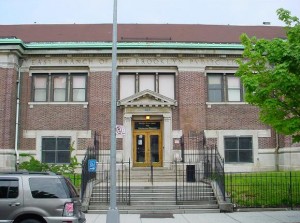BROOKLYN PUBLIC LIBRARY, ARLINGTON BRANCH
203 Arlington Avenue
Brooklyn, NY 11207
Block: 3923 Lot: 52
Lot Area: 19,500 sq ft (195’ x 100’)
Number of floors: 1
Building Area: 5,952 sq ft (estimated)
Year(s) built: 1906
Year opened: 1906
Architect(s): Richard A. Walker of Walker & Morris
Builder(s): L.W. Seaman Company
Status: Library, no designation
________________________________________________________________________
DESCRIPTION:
Architectural Classification:
Late 19th & 20th Century Revivals
Classical Revival
Materials:
Foundation: Brick
Walls: Brick, Stone
Summary:
The Brooklyn Public Library was created through state legislation in 1892 and began functioning five years later. In 1901, Andrew Carnegie signed a contract guaranteeing the erection of new public libraries in Brooklyn. In November of that year, the Sites Committee posited the five areas in Brooklyn with the greatest need for Carnegie branches. The locations were Williamsburg, Fulton, Carroll Park, Bedford, and Stuyvesant (which included Bushwick).
The formerly private Brooklyn Library collection, in addition to several small independent libraries, formed the core of the Brooklyn Public Library by 1902. These independent facilities, including Brownsville, Bedford, Fort Hamilton, Washington Irving, and Flatbush, were soon housed in Carnegie buildings. Although the Brooklyn system was an independent corporation, the New York City mayor, comptroller and borough president were on the board of trustees ex-officio, and its staff was in the civil service. The Brooklyn Public Library’s main central building was not completed until 1941.
The Arlington Branch has several characteristics of the suburban Carnegie library type. Located mostly in the less densely populated areas of the Bronx, Brooklyn, Staten Island and Queens, these branches are most often freestanding structures within a larger lot (most often they are surrounded by a lawn). Frequently, the libraries feature brick walls accented with a minimum of limestone ornamentation. The buildings most often have a symmetrical layout, large windows to allow an abundance of light into the reading rooms, and a prominent, decorative entrance.
The New York City Carnegie branch libraries were designed to be distinct structures, a new concept at the turn of the Twentieth Century when most branches were simply located in other buildings. They were intended to be important fixtures in the community and centrally located in a neighborhood. The Carnegie Committee had a policy to locate branches in close proximity to public buildings such as schools, social service centers, public baths, or YM/YWCA’s. The Arlington Branch has played this civic role in Highland Park for over a century.[i]
Narrative Description:
Originally named East Branch, this two-story, five-bay red brick structure features stone trim, and a recessed central entrance with a triangular pediment inscribed “Brooklyn Public Library Arlington Branch” beneath. Wide brick pilasters separate the bays. A large frieze, the width of three bays, inscribed “East Branch of the Brooklyn Public Library” runs beneath a dentillated cornice and an asphalt roof. The eastern wing is capped by a protruding rectangular windowed bay, and the western by a three-sided bay. Rehabs in 1951-1952 and 1980 replaced windows and entrance door and added metal security grills, which now remain only on the basement level windows. New wood entry doors and transom recalling the original were recently installed. The entire lot is surrounded by an early iron fence, with modern additions around the front entrance.
This branch has one of the best-preserved interiors of all the Carnegies. The semi-octagonal hooded entrance vestibule is intact. Its large, two-story central delivery room features two graceful wooden staircases on either side of the circulation desks that lead to reading rooms on the second level. Smaller staircases on either side with their own railing motif lead down to offices and a meeting room with whimsical wainscoting and original doors. Oak trim, paneled columns, interior doors and decorative mezzanine railing are all still intact throughout. The eastern reading room features a fireplace with an oversized hooded mantel surrounded by oak paneled reading nooks. The framing of the filled-in skylight can still be seen over the central delivery room.
____________________________________________________________________
Photos:
http://hdc.org/hdc-across-nyc/brooklyn/brooklyn-carnegie-libraries/arlington-branch/photos
____________________________________________________________________
[i] “The Trustees are of the opinion that in establishing branch libraries it is of great importance to establish them, as far as possible, in conspicuous positions on well frequented streets. In some measure the same principles should be applied that would govern in the selection of a site for a retail store. The fact that a branch library is constantly before the eyes of the neighboring residents so that all are familiar with its location will undoubtedly tend to increase its usefulness.” George L. Rives, Secretary of The New York Public Library (1901). From the NYPL Executive Committee Minutes as quoted in Phyllis Dain, The New York Public Library (New York: New York Public Library, 1972), 237, in Mary B. Dierickx, The Architecture of Literacy: The Carnegie Libraries of New York City (New York: The Cooper Union for the Advancement of Science and Art and The New York City Department of General Services, 1996), 27.
